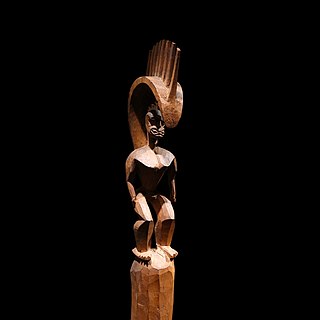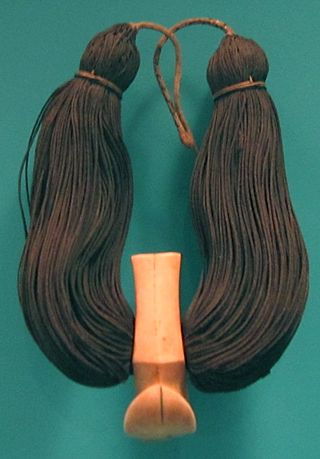
In Hawaiian religion, the god Lono is associated with fertility, agriculture, rainfall, music and peace. In one of the many Hawaiian stories of Lono, he is a fertility and music god who descended to Earth on a rainbow to marry Laka. In agricultural and planting traditions, Lono was identified with rain and food plants. He was one of the four gods who existed before the world was created. Lono was also the god of peace. In his honor, the great annual festival of the Makahiki was held. During this period, war and unnecessary work was kapu (forbidden).
The history of Hawaii describes the era of human settlements in the Hawaiian Islands. The islands were first settled by Polynesians sometime between 1000 and 1200 AD forming the modern population of Native Hawaiians. Hawaiian civilization was isolated from the rest of the world for at least 500 years.

Keōua Kalanikupuapaʻīkalaninui Ahilapalapa, sometimes called Keōua Nui was an Ancient Hawaiian noble and the father of Kamehameha I, the first King of united Hawaiʻi. He was progenitor of the House of Keōua Nui. His first name Keoua, or Ke-ao-ua means "the rain cloud" and was given to him by his subjects because of his generosity and his sacred kapu of the heavenly rains.
Keakealaniwahine (c.1640–1695), was a High Chiefess and ruler Aliʻi Nui of Hawaiʻi island.
The Aliʻi nui of Maui was the supreme ruler of the islands of Maui, one of the four main Hawaiian Islands as well as the smaller island of Lanai. The title is the same as that of the Aliʻi nui of the other islands. The title or phrase Mōʻī is sometimes used for the title of the monarchs of Maui; however, it is not an ancient word in the Hawaiian language and has origins in the mid 19th century. The only monarchs to officially hold the title of Mōʻī are Kalākaua and his sister Liliuokalani.
Kalokuokamaile, was a Hawaiian chief and first-born son of Keoua Kalanikupuapaikalaninui and half-brother of Kamehameha the Great who unified the Hawaiian Islands in 1810. He was the primogenitor of the Royal House of Keoua nui.
The House of Keōua Nui(Hale O Keōua Nui), or simply House of Keōua, is the extended royal family of Ancient Hawaii from which the reigning family of Kamehameha I and Lunalilo were descended.

For other persons with this name, please see Kamanawa II.
Haʻae was a High Chief (Aliʻi) of the island of Hawaiʻi.
Kumalae was a Hawaiian High Chief, Aliʻi Nui (ruler) of Hilo. He is also known as Kumalae-nui-a-ʻUmi.
Lono-a-Piʻilani was Aliʻi of Maui. He was a chief of that Hawaiian island and was named after god Lono.
Kawaokaohele was a High Chief who ruled the island of Maui in ancient Hawaii.

ʻUmi-a-Līloa was the supreme ruler Aliʻi-ʻAimoku who inherited religious authority of Hawaiʻi from his father, High Chief Līloa, whose line is traced, unbroken to Hawaiian "creation". Aliʻi-ʻAimoku is the title bestowed on the ruler of a moku, district or island. His mother was Akahi. She was of a lesser line of chiefs who Līloa had fallen in love with when he discovered her bathing in a river. He became Aliʻi nui after the death of his half-brother Hākau, who inherited the lands of his father to rule. ʻUmi-a-Līloa was considered a just ruler, religious and the first to unite almost all of [Hawaii (island]. The legend of Umi is one of the most popular hero sagas in Hawaiian history. While there is probably embellishment to the story, as many sagas do, a portion of historical accuracy remains.

Piʻilani ruled as Chief of the island of Maui in the later part of the 15th century. At the time Maui was an independent kingdom within the islands of Hawaii.
Kiha-a-Piilani was an Aliʻi nui of Maui. He was born ca. 1510.
Kamalālāwalu was the supreme ruler Aliʻi-ʻAimoku of Maui in ancient Hawaii, known to us today from the old chants. He was a great warrior chief and highly regarded for his leadership and resource management. Kamalālāwalu invaded Hawaiʻi Island and engaged in a disastrous battle in Kohala. Kamalālāwalu was killed and his invasion force was decimated. His son Kauhi-a-Kama survived, returned to Maui and became its next ruler.
According to the Hawaiian mythology, Kawalakiʻi is a name of one male god, but his ancestry in the myth and the attributes are unknown.
Keleanohoanaʻapiʻapi, short name Kelea, was an ancient Hawaiian noblewoman who is mentioned in ancient legends, and her genealogy is given in chants. She was a Princess of Maui, one of the Hawaiian Islands. She was a High Chiefess, but not of the highest known rank.
Kalanikaumakaowākea was an Aliʻi nui of the island of Maui in ancient Hawaii. He was named after the god called Wākea, who is the Sky father in Hawaiian religion and mythology.
Kaikilani (16th-century-17th-century), also known as Kaʻikilani nui aliʻiwahine ʻo Puna, was a High Chiefess and ruler Aliʻi Nui of Hawaiʻi island. She was a legendary figure in Hawaiian native oral tradition who dates to around the 16th century in the western calendar. Her father was Kukaʻilani and mother was Kaohukiokalani, both half-blood siblings of their father, Kealiʻiokaloa, ruling chief of Hawai'i Island.